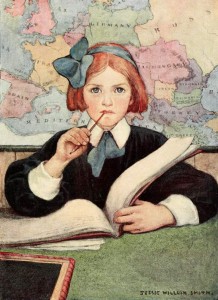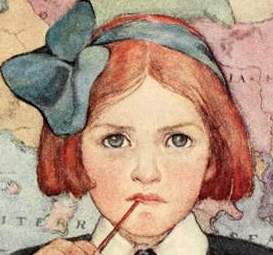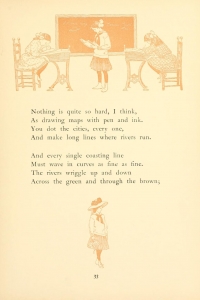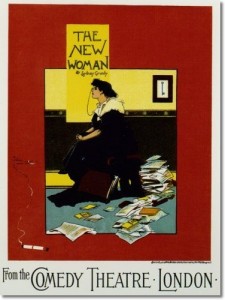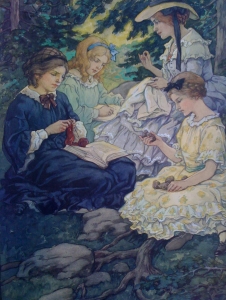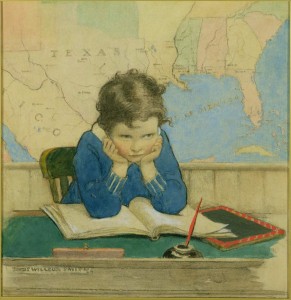Jessie Willcox Smith (1863-1935)
‘Then the Scholar’ With eyes severe, and hair of formal cut.’ 1908-09
Black and white poem illustration for ”The Seven Ages of Childhood” by Carolyn Wells in Ladies’ Home Journal (April 1909) and color version of illustration in Carolyn Wells, The Seven Ages of Childhood (New York: Moffat, Yard & Co., 1909): facing p. 34.
Here we are again as the calendar turns and so too the seasons. While in our youth, the cycle finds us once again confined in classrooms, focused on learning. A year ago, in an analysis of another illustration by Jessie Willcox Smith we discussed an illustration created for a serially published poem by Carolyn Wells in the Ladies Home Journal called “The Seven Ages of Childhood.” The fifth segment of the poem focuses on the child who has developed into a scholar.
The title of the image that Smith created to accompany this segment of the poem serves as a descriptive of the look of this young women, Then the Scholar’ With eyes severe, and hair of formal cut.’ While it is easy to recognize the girl’s formal haircut, it is more difficult to see her severe eyes. In a detail of the illustration below, it is easier to see the starkness of the concentrated look of her eyes, and her severity is communicated by both her unsmiling countenance and the pouty effect of the end of her pen’s shaft pushing up against her lower lip.
Jessie Willcox Smith also created line drawings that were published in 1909 with the book of this poem. Each of the segments used the same line drawings on all the pages of that section. For the Scholar the upper drawing is of two girls sitting at their school desks working and a third girl standing between them in front of a blackboard and reading aloud from the book she holds. Below the text is another drawing of a girl wearing a hat with her school outfit and holding a trio of books belted together as she walks to or from school. The text of the section refers both to the larger single page illustration and sometimes to the line drawn images.
The poem for this section begins,
“Nothing is quite so hard, I think,
As drawing maps with pen and ink.”
And later continues,
But drawing maps,–that isn’t all;
I was promoted in the Fall,
And now I’ve lots of bigger books.
Reading is harder than it looks.
. . . .
I look ahead, and seem to see
That knowledge waiting there for me.
I think, when I grow big and tall,
I prob’ly shall have learned it all.
Even though the poem’s words indicate that this girl is just beginning her studies, she appears to be as a scholar a vision of youthful perfection. Her dark blouse reinforces her scholarly mien. The practical black or dark blue blouse or dress was recognized as typically worn by women with a penchant for serious writing. The dark fabric helped to hide potential ink stains that might be incurred while writing with a pen nib dipped in ink bottle.
Albert George Morrow (1863-1927 Clara Miller Burd (1873-1933)
The New Woman, 1896 The Sisters Sat Together in the Shady Nook Frontispiece illustration for
Poster illustration for play by Sydney Little Women by Louisa May Alcott (Chicago: The John C. Winston Co., 1926)
Grundy at the Comedy Theatre, London Watercolor on paper
Eisenstat Collection of American Illustration
As was pointed out in a posting earlier this year, in her illustrations for Little Women, Clara Miller Burd portrayed the more serious scholarly sister Jo March in a dark dress as in the above illustration. These dark fabrics were understood as worn by more scholarly girls to help hide potential ink stains from writing while her sisters are portrayed wearing pastel colored summer dresses.*
In her Scholar illustration Smith unified the girl’s outfit by the addition of the blue neck-tie and the hair ribbon. I find it interesting that the hair ribbon is purely decorative and does not hold or confine the girl’s hair. The two bows also serve to intensify the blue of the Scholar’s eyes helping the viewer to better recognize their seriousness.
But what most interests me is that Jessie Willcox Smith revisited this composition later in 1928 for a cover illustration for Good Housekeeping magazine. In this Good
Jessie Willcox Smith (1863-1935)
Back to School Again, c. 1928
Cover illustration for Good Housekeeping (October 1928)
Housekeeping magazine cover illustration, Smith again posed a student at her desk in front of a colorful map. But instead of the image of a young Scholar concentrating on her studies, this time Smith pictured a bored girl, glowering over her text book and “trapped at her school desk while the world, exemplified by the map behind her head, rolls on outside the classroom.”** While it is true that the Scholar illustration was constructed to represent a specific segment of the Carolyn Wells poem and therefore echoes the positive mien of the poem’s words, in this iteration Smith’s illustration more likely represented a facet of her own school girl experiences, or at least her imagination of what student’s boredom looks and feels like.
* See Exploring Illustration entry “Women Who Read” web published on February 7, 2013. https://www.rockwell-center.org/exploring-illustration/women-who-read/
** To see the analysis of the 1928 Smith illustration check out Exploring Illustration entry “Back to School, Again” that was web published on September 9, 2010. https://www.rockwell-center.org/exploring-illustration/back-to-school-again/
September 5, 2012
By Joyce K. Schiller, Curator, Rockwell Center for American Visual Studies, Norman Rockwell Museum


